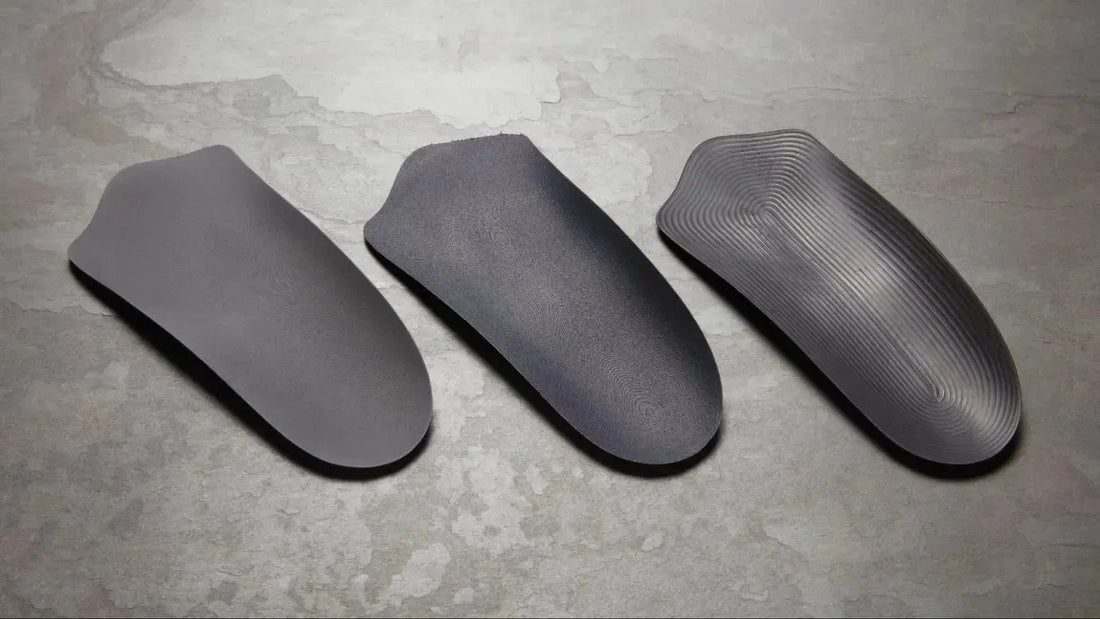
The future of orthotic production
Combining LutraCAD's cutting-edge insole and orthotic software with Mosaic's hardware solutions to modernize the workflow for labs and practitioners
Until now, the process of creating custom orthotics has been a laborious and time-consuming practice. Professionals work from casts and molds created for each patient to produce unique parts that must then be precisely milled, sanded, and glued together in layers. The amount of time and specialization required has limited both the quality and production of orthotics, resulting in higher costs for professionals and longer wait times for patients. To combat these inefficiencies, companies have turned to additive manufacturing to enable the production of custom orthotics at scale.
Mosaic Manufacturing has advanced its breakthrough multi-material 3D printing technology into a comprehensive ecosystem of supply chain solutions. At the heart of this ecosystem is Array , Mosaic’s flagship automated additive manufacturing platform. Array enables companies to scale high-volume custom part production with unmatched flexibility and affordability. By moving production closer to the point of need, Mosaic helps companies seamlessly transition to future-proof operations that reduce part costs and amplify their competitive advantage.
LutraCAD , a Dutch insole design software company, has partnered with Mosaic to revolutionize the orthotic manufacturing process. LutraCAD’s intuitive software seamlessly integrates with the Array ecosystem to create a powerful end-to-end solution. This collaboration empowers orthotic manufacturers like Ontario-based Premier Orthotic Laboratory (POL) to gain a competitive edge by offering superior custom insoles with unmatched comfort and faster turnaround times.
A new process for the production of orthoses
The traditional method of producing insoles has inefficiencies that often result in long wait times for patients who need custom insoles for everyday comfort and pain management. It all starts with a doctor scanning the patient and sending their scans to the insole lab, which will then use the data to manually fabricate the insoles. The process of forming each piece of an insole is highly technical and can produce inconsistent results, as each worker has their own approach to construction. Additionally, practitioners are limited by a narrow selection of materials, which can compromise comfort levels.
By combining their technologies, Mosaic and LutraCAD have unlocked a faster, more modernized process for producing orthotics. Instead of cycling files back and forth between professionals and labs and relying on skilled laborers to handcraft insoles, Array and LutraCAD can digitally manage production by one user to produce fast, consistent, high-quality results.
An improved overview of the workflow
LutraCAD’s design software offers step-by-step instructions for users, making it an accessible solution for all skill levels. After uploading a patient scan, manufacturers can easily fine-tune each layer of the insole prior to production, making adjustments as needed. Once the design process is complete, the file can be uploaded directly to Canvas – Mosaic’s Connected Additive Software Solution – where it is sliced and sent to Array for production. From Canvas, users are able to customize materials and print settings, as well as manage the print queue, allowing them to prioritize orders as they come in. The ability to digitally manage the scanning and design process, with software that seamlessly integrates with each other, frees up technicians to process more patient orders.
.jpg?width=760&height=667&name=LutraCAD%20Process%20(5).jpg)
With its 4 Element 3D Printers and integrated robotics system, Array has unlocked unparalleled efficiency for additive manufacturing. Once prints are completed, they are automatically moved to Array’s removable storage cart, allowing new jobs to begin without the need for manual changeovers. For orthotic professionals, Array enables the ability to produce insoles outside of business hours, while reducing the demand for skilled labor. Prints can be started from anywhere in the world, allowing for up to 72 hours of uninterrupted, lights-out production for maximum efficiency and flexibility.
Compared to traditional manufacturing methods, additive offers another key advantage for orthotic manufacturers: it produces dramatically less waste. The traditional milling process involves creating insoles from large blocks of material; as a result, approximately 80% of the material is wasted. In contrast, Mosaic’s solutions build insoles layer by layer, saving little material in the process.
Empowering End Customers
For customers like Premier Orthotics Labs, this new solution has already produced impressive results.
"Over the years I've worked as an orthopedist, I've finally found a product that feels soft on the foot but still provides adequate support. "
Fareen Samji
CEO & Founder, Premier Orthotics Labs
With 15 years of experience in the orthopedic industry, POL has earned a reputation for providing market-leading orthotics. During the COVID-19 pandemic, POL faced challenges in sourcing skilled labor to support traditional manufacturing methods. This led them to adopt additive manufacturing as a solution, not only to address labor shortages and reduce lead times, but also to improve the comfort and quality of their products .
Discover the case study with Premier Orthotics Lab
By incorporating LutraCAD software in combination with Mosaic’s Array and Canvas, POL was able to produce accurate, comfortable insoles for their customers at a fraction of the cost and time of production. Being able to scan and design orders in minutes and then schedule print jobs to run overnight unlocked a unique advantage for the lab. When staff arrived the next morning, a full run of products had been completed, giving them a head start on the long queue of orders the next day.
The Future of Digital Manufacturing
The partnership between LutraCAD and Mosaic Manufacturing marks a significant step forward in the world of orthotics. By combining cutting-edge software with the power of additive manufacturing, labs and practitioners are unlocking new levels of productivity and efficiency, reducing overall waste, and improving access to high-quality, custom orthotics for patients.


 https://www.instagram.com/3digital.tech/
https://www.instagram.com/3digital.tech/